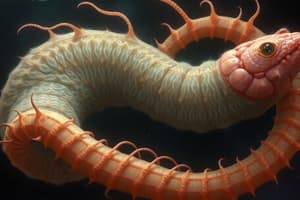Podcast
Questions and Answers
How are cestodes classified? Describe their anatomy.
How are cestodes classified? Describe their anatomy.
Cestodes, or tapeworms, are segmented platyhelminths. They consist of a scolex (head), a neck region with many proglottids, and a strobila with even more proglottids. They are simultaneous hermaphrodites, with each proglottid containing both female and male genital tracts. Eggs are produced in the distal proglottids.
Describe the life cycle of cestodes.
Describe the life cycle of cestodes.
Cestodes begin as eggs or early larvae that are ingested by intermediate hosts. The larvae are highly invasive and can cause severe disease when they penetrate the GI tract and erode tissue. Adult tapeworms develop in definite hosts after ingestion of later larval forms in undercooked fish or meat.
Are humans intermediate or definite hosts for cestodes? Which state is associated with disease?
Are humans intermediate or definite hosts for cestodes? Which state is associated with disease?
Humans can be either intermediate or definite hosts for cestodes, depending on the species and infection stage. Severe disease is associated with tissue-invasive eggs and larvae.
How are Taenia spp. classified? What are their common names? Describe their pattern of infection. How is it diagnosed? What is cysticercosis?
How are Taenia spp. classified? What are their common names? Describe their pattern of infection. How is it diagnosed? What is cysticercosis?
How is Diphyllobothrium latum classified? What disease can it cause?
How is Diphyllobothrium latum classified? What disease can it cause?
What is hydatid cyst disease?
What is hydatid cyst disease?
What are alveolar hydatid cysts?
What are alveolar hydatid cysts?
Flashcards are hidden until you start studying
Study Notes
Cestodes Overview
- Cestodes, also known as tapeworms, are segmented platyhelminths with distinct anatomical regions.
- Key segments include the scolex (head), neck region (with many proglottids), and strobilia (main body of multiple proglottids).
- They function as simultaneous hermaphrodites, possessing both male and female genital tracts in each proglottid.
- Eggs are produced in the distal proglottids.
Life Cycle of Cestodes
- Cestodes begin their lifecycle when eggs or early larvae are ingested by intermediate hosts.
- Larvae are highly invasive and can penetrate the gastrointestinal (GI) tract, leading to severe diseases, often causing eosinophilia.
- Adult tapeworms develop in definite hosts after ingestion of mature larval forms in undercooked fish or meat.
Hosts of Cestodes
- Humans can act as either intermediate or definite hosts, depending on the species and infection stage.
- Severe disease is often caused by tissue-invasive eggs and larvae, while adult cestodes may cause asymptomatic infections or nonspecific symptoms like weight loss and abdominal discomfort.
Taenia spp. Details
- Taenia solium (pork tapeworm) and Taenia saginata (beef tapeworm) are intestinal cestodes under the phylum Platyhelminthes.
- Human ingestion of cysticerci from undercooked pork or cattle leads to the development of adult worms in the intestines, potentially reaching lengths of up to 5 meters.
- Diagnosis involves finding thick-walled, spherical, dark brown eggs or proglottids in feces.
- Cysticercosis occurs with tissue invasion from embryonated T. solium eggs, leading to serious complications like blindness and epilepsy, identified through biopsy, imaging, and serum/CSF IgE.
Diphyllobothrium latum
- Known as the broad fish tapeworm, it is classified as an intestinal cestode, also under the phylum Platyhelminthes.
- Found in raw fish, the worm can be killed by freezing at -25 °C for 48 hours.
- Adult worms can grow up to 10 meters long and infections are typically asymptomatic, but can result in pernicious anemia due to vitamin B12 depletion.
Hydatid Cyst Disease
- Echinococcosis, or hydatid cyst disease, is caused by ingestion of embryonated eggs from Echinococcus granulosus, commonly associated with dog owners.
- It produces slowly growing cysts that may reach up to 20 cm in diameter over a decade, typically found in the lungs or liver.
- Hydatid cysts contain infectious protoscoleces, hydatid sand, and anaphylatoxins.
Alveolar Hydatid Cysts
- Caused by ingestion of eggs from Echinococcus multilocularis.
- Result in multiple smaller cysts that bud out and resemble alveoli, differing from the singular large cysts found in classic hydatid disease.
Studying That Suits You
Use AI to generate personalized quizzes and flashcards to suit your learning preferences.




